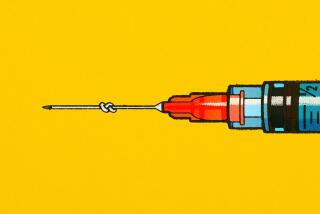Healing Within
As a teenager living in her native Venezuela, Leila Guerra spent her days swimming and lying in the sun. Bronzed and healthy, she didn’t need makeup and rarely wore it.
It wasn’t until she entered her 20s, after she moved to Las Vegas to become a singer, that her skin problems began. She wore pancake makeup while performing in a dance revue six nights a week and, as a result, she developed adult acne.
For the record:
12:00 a.m. Feb. 2, 2000 For the Record
Los Angeles Times Wednesday February 2, 2000 Home Edition Southern California Living Part E Page 3 View Desk 1 inches; 22 words Type of Material: Correction
Misspelled name--In a story about scarring (“Healing Within,” Jan. 26), the name of Jonsson Comprehensive Cancer Center at UCLA was spelled incorrectly.
She was traumatized. To disguise the problem, she wore even more makeup. She let her hair grow long. She donned large sunglasses. Eventually, she stopped going to parties and would leave the house only when necessary.
“I thought if anyone got close, they’d be disgusted,” Leila said.
She comforted herself by thinking the audience was too far away to see what her skin really looked like. But after each show, she was forced to face the truth.
“As soon as I took the makeup off, I was like, ‘Oh, my God. There I am,’ ” said Leila, who often cried when looking in the mirror. “There was a time when makeup couldn’t do it anymore.”
Having neglected medical treatment, Leila, now 40, is permanently scarred.
Scarring is particularly hard on women, who often feel stripped of their femininity. The extent of a scar’s psychological wounds depends on how much she feels societal pressure.
And there is a lot of pressure. Whether the images are airbrushed or real, television, movies, fashion magazines and advertisements have a history of portraying women’s skin as perfect. In a country where women spend $6.2 billion a year on cosmetics, Leila’s embarrassment is typical. And it is part of what has propelled scar management into a $334-million-a-year industry.
Until the mid-’90s, plastic surgery was the primary option for scar minimization. Then chemical peels, collagen injections and laser resurfacing were introduced. The number of laser resurfacing treatments performed by dermatologists nationwide doubled between 1995 and 1997; the number of soft-tissue injections, including collagen, increased 28% during that time, according to a study by the American Society for Derma Surgery.
While the medical community sees scars as evidence of a healthy immune system, Ian Scott, spokesman for the Scar Information Service in Hull, England, says those left with scars often take little comfort in that.
“Most [doctors] dealing with wounds think that when they’ve got a scar, their job is almost complete because the wound has healed,” Scott said. “The message we’re trying to get over to . . . the medical profession is that their care need not necessarily be over when the wound is healed. There is still the psychological issue of what has happened to that person.
“To some people, even the smallest mark can have huge psychological effects.”
In a national study commissioned by ReJuveness, a scar-treatment product, 65% of female respondents said they were self-conscious about their noticeable scars, compared with 35% of male respondents. This 2-to-1 ratio was echoed in a similar study by the Scar Information Service.
Complete Erasure
Remains Elusive
And as more women turn to modern medicine to capture a physical ideal, there still is no way to remove scars completely. Treatment options now include plastic surgery, laser resurfacing, steroid injections, radiation, silicone sheeting, chemical peels, skin grafts and dermabrasion. However, success depends on the size and severity of the scar, the thickness and color of the skin, and the size and depth of a wound. Whether such treatments are covered by medical insurance depends on the nature and source of the scar. If the treatment is strictly cosmetic, most health insurance providers will not cover the cost.
Treatments range in price from about $100 (for fading creams) to $5,000 (for a full-face laser resurfacing), according to Josh Wieder, assistant clinical professor of dermatology at UCLA. Wieder says the most common treatment is bleaching cream.
Wieder says he often sees patients who ask about procedures that may not be appropriate for their condition and that expectations sometimes exceed realistic results.
“It’s my job to educate people beforehand about what’s a realistic expectation,” he said. “[You] can’t treat someone who’s got severe, ice-pick, depressed scarring and tell them it will be baby smooth. If you tell them they can expect 40% improvement, then that’s more realistic.”
“Women who will be left with a scar have alterations in their body image,” said Dr. Anne Coscarelli, director of the Rhonda Fleming Mann Resource Center for Women With Cancer at UCLA’s Johnson Cancer Center. “They’re uncomfortable with their scars and uncomfortable showing their scars to people. It alters their relationships in many situations. Some women no longer feel comfortable in sexual encounters. They may need to be clothed or partially clothed. It can have quite a significant impact not only on the individual but on the relationships that exist.”
Kate, 34, an actress from Burbank who asked that her full name not be used, has two diagonal scars on her chest and two more on her abdomen, the result of a preemptive double mastectomy performed two years ago. Since the surgery, she has not been involved in a romantic relationship. She feels too vulnerable.
Kate said she has difficulty trusting men.
Kate acknowledges that her decision to have a double mastectomy without reconstructive surgery was an unusual one, especially for someone her age. But Kate, whose mother and grandmother each had breast cancer, chose health over aesthetics. She said she wanted “to get back to what’s important about being a woman, which is not these parts of us, these outside, external parts.” When she told one doctor what she planned, she said, he responded, “There goes your social life.”
“It was kind of difficult to convince a surgeon that I wanted both breasts removed. They couldn’t understand a woman choosing that,” she added.
“Our society is very breast-focused,” Coscarelli said. “We use breasts to sell almost every product that exists, and when you actually are left not only without a breast but now with a scar, it’s a very significant and traumatic event.”
Though time, aloe and vitamin E have helped Kate’s scars to fade, there remains the pain of people’s reactions.
“I’m proud of the step that I took to save my life,” she says. “What hurts the most is that I’m not in a society that supports that. I’m not recognized for being strong and brave--for having gotten through it.
“I love the idea of scars,” she added. “I love the idea of other cultures using scars as rites of passage.”
But we don’t live in such a society, even though statistics show the average American has 4.6 noticeable scars. The U.S. government estimates that 62 million new scars occur here each year--including 23 million from surgical procedures, 37.7 million from injuries, 1 million from caesarean sections and 1.25 million from burns.
“You look at some societies, particularly in Africa, where they deliberately go out of their way to scar themselves. It is a ritual, a sign of pride,” said Scott, of the Scar Information Service. “But in Western culture, that is not the case.”
A Culture in Which
Scars Are Stigmatized
In Nubia, for example, girls are ritually scarred with each step toward womanhood. A girl receives her first set of scars when her breasts begin to appear, another at the onset of menstruation and a final set after weaning her first child. In Nigeria, a girl’s scarring begins at age 5 and continues throughout her lifetime--a validation of her femininity and sexual power.
There is no parallel for women in American society. While scarification rituals in other cultures are often a means of connecting individuals to the community as a whole, here, unintentional or accidental scars have the opposite effect. They can alienate.
“In today’s society, beautiful equals good. Ugly equals bad,” Scott said. For many, scars bring up fears, even reminders of our own mortality.
“People want to know what happened until you tell them,” said Chaia, a 40-something public relations consultant.
In 1984, she was attacked moments after she got off a bus near her Santa Monica home. She was stabbed 10 times in the back, chest, legs, arm and neck with a 12-inch hunting knife. The puncture wounds took years to heal and left 2- and 3-inch-long red, raised scars on those parts of her body.
“My scars are nothing compared to what some people have gone through,” said Chaia, who recognizes that while scars can not be entirely healed, the way she perceives them can be. “It’s so stupid to be so upset over just a little scar. ‘Get over it’ is what I say.”
Making Peace
With Trauma
Indeed, for some women scars renew their appreciation for life.
Rita, 45, of Arcadia, is a computer consultant. Until two years ago, her skin was taut and smooth.
“At my age, most of my friends [had] some dark spots on their face. I didn’t have any. I [was] proud [of] my skin,” says Rita, who now is scarred over 99% of her body.
In May 1998, she changed birth control pills. Three days later she broke out in blisters over her entire body, a victim of Steven Johnson Syndrome, a rare medical condition. Over the course of one month, she lost her eyelashes, her fingernails and most of her skin, which, after numerous skin grafts, injections, bleaching creams and pressure bandages, is still uneven in both pigment and texture. Because she is Chinese American and has more pigmentation in her skin, she was more susceptible to scarring.
Yet Rita sees only the positive in her situation.
“I realized I had so many friends,” she said. “They care so much about me. They don’t care how I look, so why should I care how I look?”
Married 22 years, with two daughters, ages 12 and 17, Rita found it was her family who had the most difficulty adjusting.
Rita had always been the hip mom--the one who wore blue nail polish and Guess jeans. When her 12-year-old daughter recently caught her looking at a picture of herself and her husband from a few months before she was hospitalized, her daughter asked, “Mommy, why [are] you looking at that picture? Don’t do that.”
Rita replied, “Why not? By looking at the picture, I’ll appreciate how much improvement I have.”
Rita is at peace with her scars. She doesn’t care who sees them. But her husband is concerned. For him, it is an issue of politeness. He thinks Rita’s scars scare people. Sometimes when Rita wears sleeveless shirts, he asks, “Why [are] you wearing that, showing your scars?”
Rita answers, “I wear that because I feel like [wearing] it.”
“The fact is that there will be people who it won’t matter [to] and other people who will look at your skin and say, ‘Ugh.’ That’s just the way it is,” said Leila, who within the last year has sought treatment for her skin. Still, she wore makeup to her first dermatology appointment.
She adds, “Even people with gorgeous skin want to have even more gorgeous skin.”
Susan Carpenter can be reached at [email protected].
For more reviews, read Book Review
* Sunday: David Craig on George Mallory’s last climb and the ghosts of Mt. Everest; Diane Johnson on Dashiell Hammett’s novels and short stories; Michael Frank on a culinary history of food; and Jonathan Levi on Ingo Schulze’s “Simple Stories: A Novel From the East German Provinces.”
More to Read
Sign up for Essential California
The most important California stories and recommendations in your inbox every morning.
You may occasionally receive promotional content from the Los Angeles Times.










